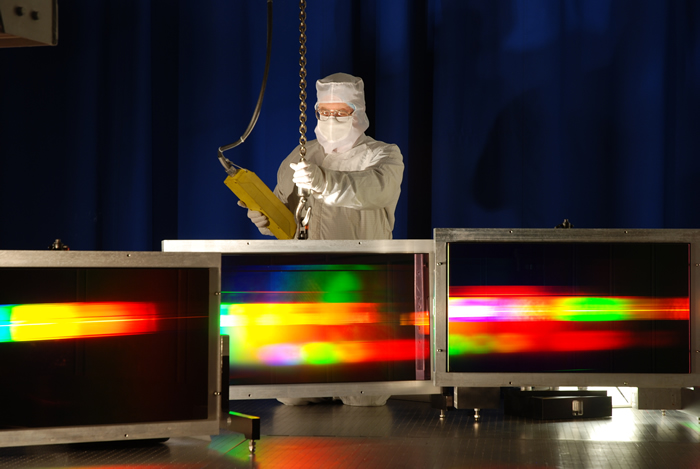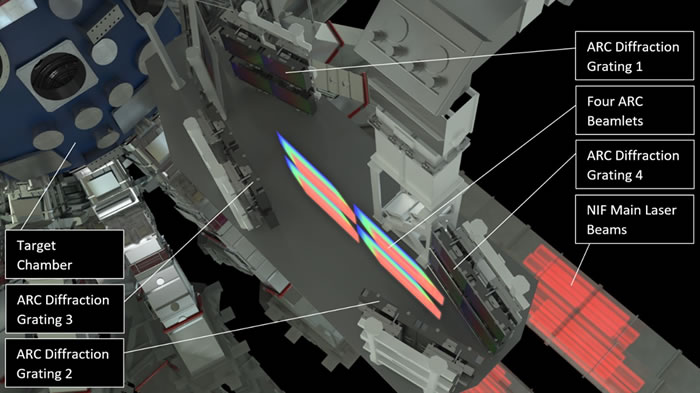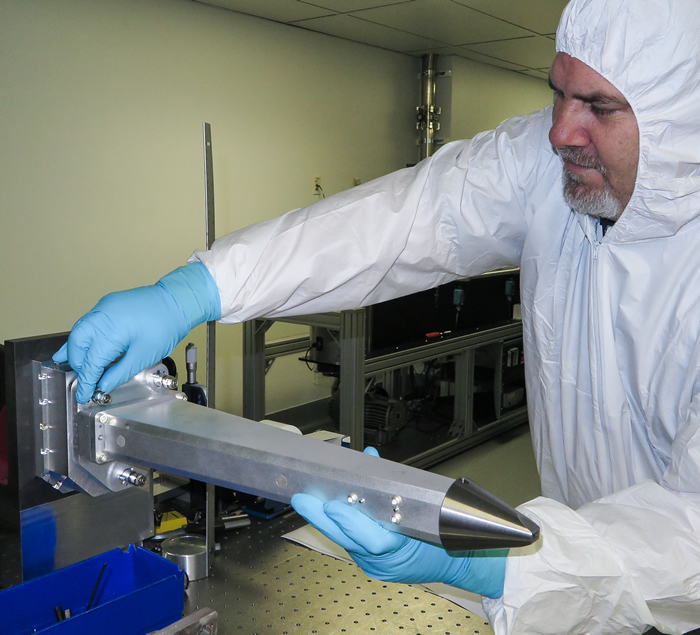ARC Explores the Frontiers of Science
 A technician maneuvers three of 16 diffraction gratings during their production for the Advanced Radiographic Capability (ARC) laser. Installed in groups of four inside ARC’s compressor vessel, the gratings compact ARC’s beamlets, making them extremely powerful just before they enter the NIF Target Chamber.
A technician maneuvers three of 16 diffraction gratings during their production for the Advanced Radiographic Capability (ARC) laser. Installed in groups of four inside ARC’s compressor vessel, the gratings compact ARC’s beamlets, making them extremely powerful just before they enter the NIF Target Chamber. NIF’s petawatt-class Advanced Radiographic Capability (ARC) laser gives researchers an unparalleled diagnostic tool for stockpile stewardship, as well as a powerful energy source that can drive experiments investigating the frontiers of science.
“ARC is a spectacular example of a new diagnostic that’s been successfully developed, taking many years to get here, bringing us information that could be obtained no other way.”
—LLNL Director Bill Goldstein
One of the world’s highest-energy short-pulse lasers, ARC uses two NIF beamlines split into four rectangular beamlets, forming “a laser within a laser.” To achieve its petawatt (quadrillion-watt)-class power, ARC uses a process called chirped pulse amplification to increase the power of the beamlets. Former LLNL employee Donna Strickland shared the 2018 Nobel Prize in physics for co-inventing this technology (see “Nobelist’s Invention Helped Spark LLNL’s Short-pulse Laser Breakthroughs”).
ARC’s first shot into the Target Chamber was in March 2015. High energy density (HED) experiments using ARC began after full commissioning in December 2015. When used as a backlighter for HED and inertial confinement fusion (ICF) shots, ARC’s 10-30 picosecond-long pulses impact tiny gold wires to generate high-energy x rays that can penetrate and image dynamics in highly opaque or high-areal-density targets. Similar to x rays taken at a doctor’s office, the x rays from ARC produce radiographs that allow researchers to see details of what’s happening as complex targets evolve.
 When fielded during a NIF experiment, four ARC beamlets become much more powerful after they strike a series of diffraction gratings, part of the chirped pulse amplification process. The beamlets are then focused at the center of the target chamber, where researchers can conduct their investigation. Credit: Jake Long
When fielded during a NIF experiment, four ARC beamlets become much more powerful after they strike a series of diffraction gratings, part of the chirped pulse amplification process. The beamlets are then focused at the center of the target chamber, where researchers can conduct their investigation. Credit: Jake Long ARC also allows scientists to explore extreme states of matter and to generate exotic particles, such as matter-antimatter pairs and proton beams. ARC-generated proton beams for ultrafast heating of matter to extreme states will enable opacity and equation-of-state measurements at unprecedented energy-density states. The experimental platforms developed, and the scientific understanding gained, from ARC shots inform many other NIF experiments, making ARC an invaluable asset to NIF’s HED experiments, the Discovery Science program, and in the pursuit of ignition.
 Technician Tim Cunningham prepares the ARC X-ray Imaging System (AXIS) diagnostic snout for its first data shot on March 1, 2016. Credit: James Pryatel
Technician Tim Cunningham prepares the ARC X-ray Imaging System (AXIS) diagnostic snout for its first data shot on March 1, 2016. Credit: James Pryatel More Information:
“NIF | How the ARC Laser Works” (LLNL animation)
“An Inside Look at the Advanced Radiographic Capability (ARC) Laser”
“Advanced Radiographic Capability (ARC) Laser”
“Two World-Class Lasers Combine to Power Applications,” Science & Technology Review, September 2018
“ARC Proton-Acceleration Experiments Exceed Expectations”
“NIF Creates Matter and Antimatter from Light”
Next Up: Users and Partners



